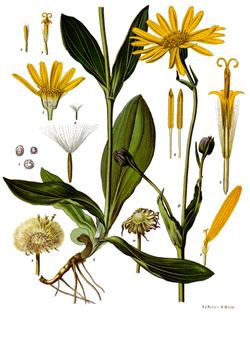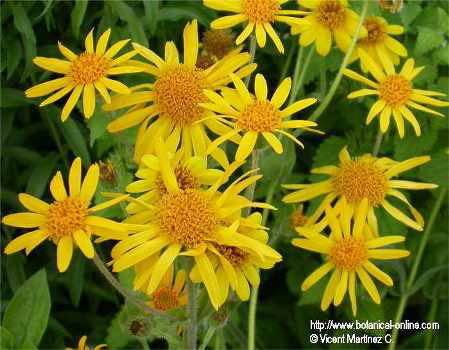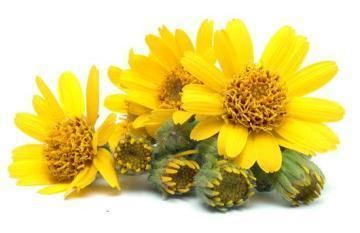Tribe Heliantheae Scientific name Arnica | Subfamily Asteroideae Subtribe Madiinae Rank Genus | |
 | ||
Lower classifications Mountain arnica, Arnica chamissonis, Arnica cordifolia, Arnica latifolia, Arnica mollis | ||
Arnica montana homeopathic medicine tips for beginners
Arnica /ˈɑːrnᵻkə/ is a genus of perennial, herbaceous plants in the sunflower family (Asteraceae). The genus name Arnica may be derived from the Greek arni, "lamb", in reference to the plants' soft, hairy leaves. Arnica is also known by the names Mountain Tobacco and, confusingly, Leopard's bane and Wolfsbane—two names that it shares with the entirely unrelated genus Aconitum.
Contents
- Arnica montana homeopathic medicine tips for beginners
- Characteristics
- Arnica montana
- Medicinal uses
- Toxicity
- Homeopathy
- Species
- References

This Circumboreal and montane (subalpine) genus occurs mostly in the temperate regions of western North America, with a few species native to the Arctic regions of northern Eurasia and North America.

Several species, such as Arnica montana and A.chamissonis, contain helenalin, a sesquiterpene lactone that is a major ingredient in anti-inflammatory preparations (used mostly for bruises).

Arnica species are used as food plants by the larvae of some Lepidoptera species including Bucculatrix arnicella.
Arnica was previously classified in the tribe Senecioneae because it has a flower or pappus of fine bristles.
Characteristics

Arnica plants have a deep-rooted, erect stem that is usually unbranched. Their downy opposite leaves are borne towards the apex of the stem. The ovoid, leathery basal leaves are arranged in a rosette.

They show large yellow or orange flowers, 6–8 cm (2–3 in) wide with 10–15 cm (4–6 in) long ray florets and numerous disc florets. The phyllaries (a bract under the flowerhead) has long spreading hairs. Each phyllary is associated with a ray floret. Species of Arnica, with an involucre (a circle of bracts arranged surrounding the flower head) arranged in two rows, have only their outer phyllaries associated with ray florets. The flowers have a slight aromatic smell. If taken in the wrong dose it can be very dangerous.
The seedlike fruit has a pappus of plumose, white or pale tan bristles. The entire plant has a strong and distinct pine-sage odor when the leaves of mature plants are rubbed or bruised.
Arnica montana
The species Arnica montana, native to Europe, has long been used medicinally, but the effectiveness of this use has not been substantiated.
Medicinal uses
According to The Memorial Sloan-Kettering Cancer Center, "A few clinical trials suggest benefits of topical arnica for osteoarthritis; and for affecting significant reduction of bruising compared to placebo or low concentration vitamin K ointments.
A study of wound-healing after surgery to treat varicose veins found no statistically significant proof of efficacy.
Toxicity
Arnica montana contains the toxin helenalin, which can be poisonous if large amounts of the plant are eaten, and contact with the plant can also cause skin irritation. If enough of the material is ingested, the toxin helenalin produces severe gastroenteritis, and internal bleeding of the digestive tract. Homeopathic preparations of Arnica 24X dilution or more contain no active ingredient and are, therefore, ineffective and non-toxic.
Homeopathy
Homeopathic preparations of Arnica are widely marketed and used. In the UK, the Medicines and Healthcare products Regulatory Agency has registered the product for sprains and bruising under the National Rules for Homoeopathic Products (2006). These rules allow claims of efficacy for these conditions to be made on the packaging in the absence of similar evidence to that required for conventional medicines under the Medicines Act 1968 and 1971. A systematic review of clinical trials showed that homeopathic Arnica was no more effective than a placebo. In some quarters, the fact that homeopathic Arnica has been the subject of published clinical trials at all has drawn criticism grounded on the allegation that the basic premise of the high dilutions used in homeopathy would be inherently flawed.
Species
Accepted species:
- Arnica acaulis —Common Leopardbane - eastern US from Alabama to New Jersey
- Arnica angustifolia —Narrowleaf Arnica - Canada (from British Columbia to Quebec), US (Montana, Idaho, Wyoming, Colorado); Russia, Scandinavia
- Arnica cernua —Serpentine Arnica - California, Oregon
- Arnica chamissonis —Chamisso Arnica - US West of Rockies incl Alaska; Canada (British Columbia to Quebec plus Yukon + Northwest Territories)
- Arnica cordifolia —Heart-leaf Leopardbane, Heartleaf Arnica - US West of Rockies plus Alaska + Michigan; Canada (from British Columbia to Quebec plus Yukon + Northwest Territories)
- Arnica dealbata - California
- Arnica discoidea Rayless Arnica - California, Oregon, Nevada, Washington
- Arnica fulgens Foothill Arnica, Orange Arnica, Shining Leopardbane - USA= West of Rockies plus Michigan; Canada (from British Columbia to Manitoba)
- Arnica gracilis —Smallhead Arnica (A. latifolia x A. cordifolia) - US (Montana, Idaho, Wyoming, Colorado, Oregon, Washington); British Columbia, Alberta, Northwest Territories
- Arnica griscomii - Russia, Canada, Alaska
- Arnica intermedia - eastern Russia (Yakutskiya, Khabarovsk, Magadan)
- Arnica lanceolata —Arnica, Lanceleaf Arnica - US West of Rockies plus Alaska, Maine New Hampshire, Vermont, New York State; Canada (British Columbia, Quebec, New Brunswick)
- Arnica latifolia —Broadleaf Arnica - western US, western Canada
- Arnica lessingii —Nodding Arnica - Kamchatka, Alaska, Yukon, Northwest Territories, British Columbia
- Arnica lonchophylla —Longleaf Arnica - most of Canada; Alaska, Montana, Minnesota, South Dakota
- Arnica longifolia —Longleaf Arnica, Spearleaf Arnica - US West of Rockies, British Columbia, Alberta
- Arnica louiseana —Lake Louise Arnica - British Columbia, Alberta
- Arnica mallotopus - Honshu Island in Japan
- Arnica mollis —hairy arnica, wooly arnica - - US West of Rockies plus Alaska, New Hampshire + Vermont; Canada (from British Columbia to Quebec plus Yukon + Northwest Territories)
- Arnica montana — Mountain Arnica - most of Europe plus Greenland; naturalized in India
- Arnica nevadensis —Nevada Arnica - California, Oregon, Nevada, Washington
- Arnica ovata - British Columbia Alberta, Yukon, US West of Rockies
- Arnica parryi —Nodding Arnica, Parry's Arnica - British Columbia, Alberta, Yukon, US West of Rockies
- Arnica porsildiorum - Kamchatka, Yukon Northwest Territories
- Arnica rydbergii —Rydberg Arnica, Rydberg's Arnica, Subalpine Arnica - British Columbia, Alberta, northwestern USA
- Arnica sachalinensis - Hokkaido, Sakhalin, Kuril, Irkutsk
- Arnica sororia —Twin Arnica - British Columbia, Alberta, Saskatchewan, US West of Rockies
- Arnica spathulata —Klamath Arnica - California Oregon
- Arnica unalaschcensis —Alaska Arnica - Hokkaido, Honshu, Kamchatka, Sakhalin, Kuril, Alaska
- Arnica venosa —Shasta County Arnica - California
- Arnica viscosa —Mt. Shasta Arnica - California, Oregon
